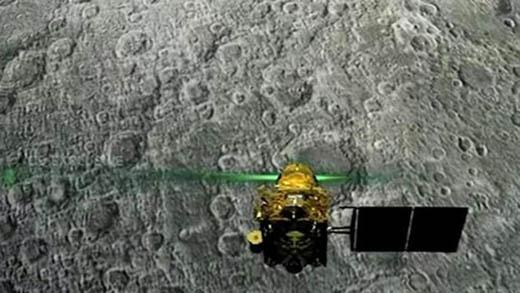As Lunar night falls, hope of contacting Chandrayaan-2’s Vikram lander fades: Experts
Mangalore Today News Network
New Delhi, Sep 21, 2019: The beginning of lunar night between Friday and Saturday at the landing site of Vikram lander marked the end of Indian Space Research Organization’s (Isro’s) hope of re-establishing communication with it, Hindustan Times reported.

Vikram is not designed to withstand temperatures of -180 degrees C and the electronics onboard will become unviable after the lunar night, equivalent to fourteen days on Earth. It will also run out of charge if the solar panels were not deployed after the ‘hard-landing’.
The temperature is about 130 degrees C during the day.
Isro scientists have been trying to communicate with the lander since September 7, when the last phase of the 15-minute powered descent did not go as planned. Scientists lost communication with the lander when it was just 2.1 km above the lunar surface.
“We can now say that there is no hope of Isro communicating with the lander, the mission life of the lander-rover is over. The mission was designed to conduct experiments during the lunar day and does not have the kind of shielding that can keep the electronics warm and functioning,” said Nirupam Roy, assistant professor of Physics at the Indian Institute of Science (IISc), Bangalore.
“And, it was unnecessary too. The fourteen days were sufficient for the lander-rover to conduct all the experiments and send back the data. The shielding would have just added weight and cost to the mission,” he added.
For the Vikram lander to be able to communicate, it should have enough power and the antenna should be properly oriented. There are two ways that the Vikram could communicate either with the Orbiter going around the moon or directly with the Earth.
“The Vikram lander communicates in two frequencies – the X band that is high bandwidth (better quality) but very focused, which could be picked by the orbiter when it is over the landing site. The other S-band, which has lower bandwidth, but is omnidirectional can be used to communicate with the Earth, but even the antenna should be facing the Earth without anything in between. However, with the lunar night setting in, there is no possibility of communicating with the lander, even if it had survived the landing,” said Jatan Mehta, former science officer of TeamIndus, a Bangalore-based private company that aims to send a lander-rover to the moon.
- Karavali Utsava: Tiger Cubs Released for Public Viewing at Pilikula Biological Park
- Kepu Cockfighting Case: 27 Booked, Including Former MLA and BJP District President
- Man held for sexually assaulting minor girl in Uppinangady
- Deep-sea fishing boat sinks off Malpe coast; crew rescued
- Fake Sri Mookambika Temple Website Scam: Youth Arrested
- BJP to approach President over hate speech prevention Bill: Shobha Karandlaje
- Ullal: Govt school PE teacher found dead in well
- Month-long Karavali Utsav kicks off in Mangaluru
- Documentation vital for research on ’bhutaaradhane’ in digital age: Prof. Vivek Rai
- Puttur MLA Allegedly Obstructs Police Operation, conducts cockfighting in Kepu
- Sushanth Brahmavar scripts Bhagavad Gita in 5.5 hours, sets new world record
- Brahmavar: Illegal foreign nationals found at resort; case registered against owner
- Vittla: Two houses gutted in fire
- ISRO to Launch BlueBird Block-2 Communication Satellite on December 24
- Nine Killed, 10 Injured in Mass Shooting Near Johannesburg
- Indian Visa Centre in Chittagong Suspended Amid Security Concerns
- Krishna, Hanuman were greatest diplomats: Jaishankar
- Veteran Malayalam Actor and Filmmaker Sreenivasan Passes Away at 69
- Leaving me bloody: Passenger alleges assault at Delhi airport, Air India Express grounds pilot
- ED attaches assets of Yuvraj Singh, Sonu Sood, and others in illegal online betting base
- 5 Rajdhani Express coaches derail, 7 elephants killed after collision in Assam
- Kerala-bound bus catches fire near Nanjangud; 40 passengers escape unhurt
- Govt must take up with Bangladesh issue of safety of minorities: Priyanka Gandhi
- National Herald: ED moves Delhi HC against order refusing cognisance of charge sheet against Gandhis
- Low visibility hits flight ops in Delhi, over 150 flights cancelled; Indigo issues advisory
- Mangaluru Student Goes Missing; Ullal Police Register Case
- APD Foundation Joins WHO Civil Society Commission
- Daiva’s prediction comes true: Janardhan Reddy walks free from jail
- Skills and Competencies Take Center Stage at MSN Dialogue Series
- Court remands Maoist Lakshmi to six-day police custody
- Sandhya Shenoy honored with Society for Materials Chemistry Medal-2024
- White Cornus Apartment in Mangaluru
- City girl wins first place in state-level spell bee competition
- Alleged ‘Love Jihad’ Case in Mangaluru: Woman left home voluntarily, says police
- Girl fatally struck by reckless two-wheeler near Belman
- New residential complex for the judges inaugurated in Mangaluru
- Absconding accused nabbed after 8 years
- Truck with cylinders turns turtle in Beltangady
- Bhoota Kola artist dies of cardiac arrest
- Development of the country should be our goal: Ganesh Karnik
- CITY INFORMATION
- TRAVEL
- TOURIST INFORMATION
- HEALTH CARE
- MISCELLANEOUS




 Write Comment
Write Comment E-Mail To a Friend
E-Mail To a Friend Facebook
Facebook Twitter
Twitter  Print
Print 

